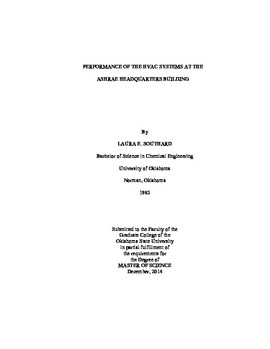| dc.contributor.advisor | Spitler, Jeffrey D. | |
| dc.contributor.author | Southard, Laura | |
| dc.date.accessioned | 2016-01-20T15:44:57Z | |
| dc.date.available | 2016-01-20T15:44:57Z | |
| dc.date.issued | 2014-12-01 | |
| dc.identifier.uri | https://hdl.handle.net/11244/25719 | |
| dc.description.abstract | When the ASHRAE headquarters building in Atlanta, Georgia was renovated in 2008, it incorporated three separate HVAC systems - a variable refrigerant flow (VRF) system, a ground source heat pump (GSHP) system, and a dedicated outdoor air system (DOAS). An extensive array of sensors monitors the operation of the HVAC equipment and the conditions in each zone in the building. This study compares the performance of the GSHP and VRF systems, determining both the energy consumption and the amount of heating and cooling provided by each system.Data relating to the operation of the HVAC systems was collected and analyzed for July 2011 through June 2013. The data indicate that the VRF system used twice as much energy as the GSHP system over the two-year time span while maintaining similar zone temperatures. The primary factors affecting the energy consumptions are the control strategies of the two systems, the ground loop water supply temperatures, which were more favorable than ambient air temperatures for heat rejection and extraction, and the amount of cooling and heating provided by each system.Three different approaches were used to estimate the cooling and heating provided by the GSHP system. Only one method was applicable to the VRF system, and that method became unsuitable after March 2012 due to equipment modifications. Another approach involved predicting the cooling and heating loads using a building simulation model with measured lighting and plug loads, DOAS contributions and historical weather data. Both the model predictions of building loads and the estimates of actual cooling and heating provided confirm that the GSHP system has higher efficiencies than the VRF system.Not all of the energy used by a GSHP system is power input to the heat pump units while they are running. Energy is also used by the circulation pumps, the blowers of units in ventilation mode, and the unit controls during standby mode at night and on weekends. The contribution of each of these to total energy use was also analyzed. | |
| dc.format | application/pdf | |
| dc.language | en_US | |
| dc.publisher | Oklahoma State University | |
| dc.rights | Copyright is held by the author who has granted the Oklahoma State University Library the non-exclusive right to share this material in its institutional repository. Contact Digital Library Services at lib-dls@okstate.edu or 405-744-9161 for the permission policy on the use, reproduction or distribution of this material. | |
| dc.title | Performance of the Hvac Systems at the Ashrae Headquarters Building | |
| dc.type | text | |
| dc.contributor.committeeMember | Fisher, Daniel E. | |
| dc.contributor.committeeMember | Beier, Richard A. | |
| osu.filename | Southard_okstate_0664M_13639.pdf | |
| osu.accesstype | Open Access | |
| dc.description.department | Mechanical & Aerospace Engineering | |
| dc.type.genre | Thesis | |
